By Mark Daffey
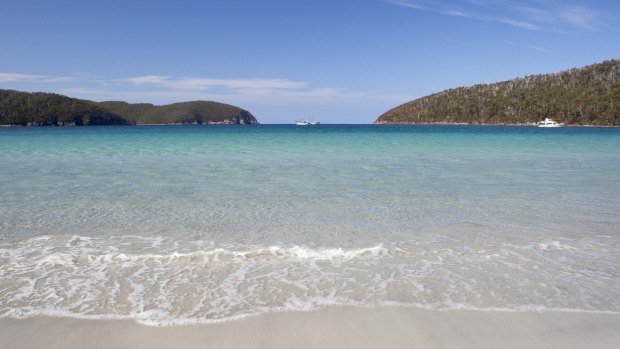
Fortescue Bay with its nearly touching headlands.Credit: Mark Daffey
It's late afternoon when a Chinese tour group floods into the Bridestowe Lavender Farm gift shop. Holidaymakers from Beijing and Shanghai load up with soaps and sprays and recipes for lavender-laced ice creams. And there's a rush on purple bears.
"Bobby the Bear is the most recognisable Australian icon in China – ahead of Qantas, koalas and kangaroos," owner Robert Ravens says. "It's true," he says, observing my sceptical look. "And it's all because of these movies."
He gestures towards a flat-screen television mounted above a generously proportioned display filled with calendars and postcards all paying homage to this unlikely film star. Three-minute videos on continuous loop showcase a loveable soft toy that gets itself into a variety of sticky situations.
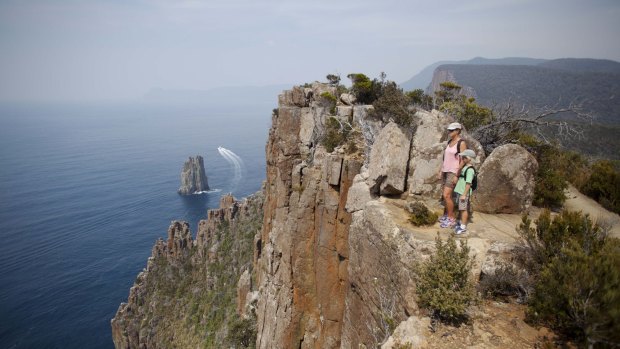
The dramatic cliff face at Cape Hauy.Credit: Mark Daffey
"They play on the ABC channel in China," Ravens says.
The idea for Bobby the Bear was hatched over a lunch in Woolloomooloo and took off almost immediately. "We're told that it's tracking ahead of Pepper Pig at the same stage, so it's going well," Ravens says. So well that a further 50 episodes, all filmed onsite, are planned.
While Bobby the Bear has become Australia's answer to Jackie Chan, he's not the reason I've come to Bridestowe with my family. It's harvest season, and the lavender crops are in full bloom. We're informed, however, that we've just missed their peak.
The next feeding time is more civilised, as well as interactive.
"You should have been here 10 days ago," Ravens says. "Had you arrived then you would have seen the flowers at their best. As it is, they've dried out so the colours have faded. You could have seen them that colour." He signals towards a framed photograph on the wall opposite the TV. It illustrates row upon row of violet blooms curving towards a mountainous backdrop.
Since our holiday dates didn't quite match that of the lavender harvest, there's nothing we could have done about it. We'd only just arrived in Tasmania that morning after collecting our JUCY campervan in Melbourne, loading it up with gear then catching the overnight Spirit of Tasmania ferry service to Devonport. After a quick stop at a supermarket for food we zipped across to the state's north-east corner, hoping to arrive at Bridestowe ahead of the last tour of the day.
It's our first port of call on a week-long campervan trip down the east coast, and although we've come with only vague plans of where we'll go and how long we'll stay in each location, already it looks like we've sold the state short. Getting from place to place takes us longer than we expect and there is much to distract us along the way.
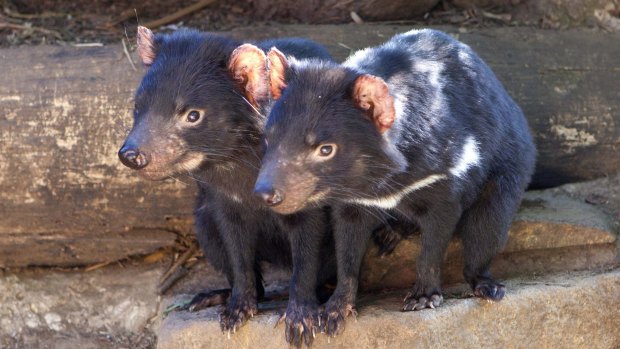
Residents of the Tasmanian Devil Unzoo.Credit: Mark Daffey
This is evident on our second day when we drive to Binalong Bay, a series of white-sand coves and boulder-strewn beaches, that lies within a greater coastal area known as the Bay of Fires. Distance-wise it's only 100 kilometres, but it takes us until mid-afternoon to get there. We pause to hike along a designated rainforest walk and a diversion down a side road through dairy fields ends at a pub where the main attraction is a beer-swilling swine.
When we eventually arrive at Binalong Bay, we opt for a campsite at Cosy Corner South. Sand dunes separate us from a magnificent stretch of beach while sheltering us from the prevailing easterlies, and a freshwater lagoon proves ideal for an afternoon dip out of the wind. Best of all though, the campsite is free.
During the next two days I ponder the good fortune it must take to live in Tasmania and be able to stay in a place like this for nothing. Tea-trees and peppermint gums border the campground on one side and turquoise-tinted swells line the other. Our only concern is the heat. The sun here has an intensity all its own, and between the three of us we apply enough sunblock to keep the palm oil industry going for another year.
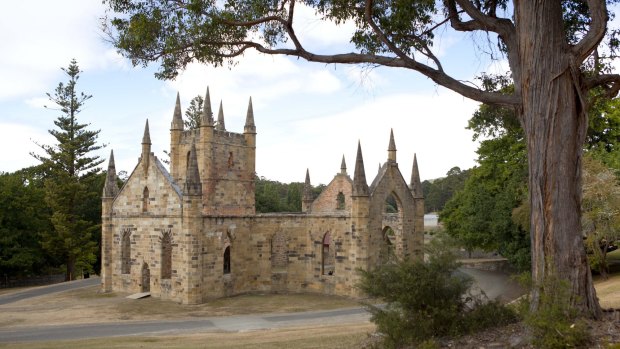
The Port Arthur Historic Site, once a convict settlement. Credit: Mark Daffey
Grey clouds blanket the sky on our third morning in Binalong Bay. The air is smoky from bushfires that are blazing in the state's north-west and the temperature has dipped. All make this a good day for driving.
The journey south to the Tasman Peninsula is long and slow. We're told the state is suffering its worst drought in decades, yet the scenery is absorbing. One minute we're passing through rolling farmlands and the next we're bordered by sloping vineyards. The beaches are as good as they get and nowhere else is our history on display as it is here, where you can find more Georgian buildings than in any other state in Australia.
After a detour to the Freycinet Peninsula so we can hike to Wineglass Bay, it's late when we eventually stop outside the Dunalley Hotel at the neck of the Tasman Peninsula. I venture inside to ask about camping and find three men standing at the bar, looking and sounding like they're in good spirits. The barmaid is a friendly gal who tells me it's a gold coin donation to camp in the paddock next door.
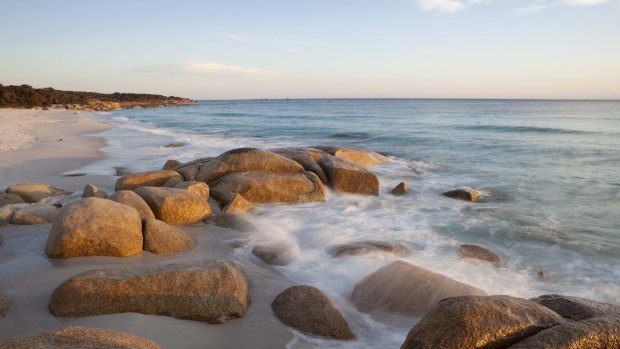
Rocks on the Bay of Fires Beach.Credit: Mark Daffey
"Where do I pay the money?" I ask.
"Right here with us," says one of the men.
"We'll look after it," another pipes in.
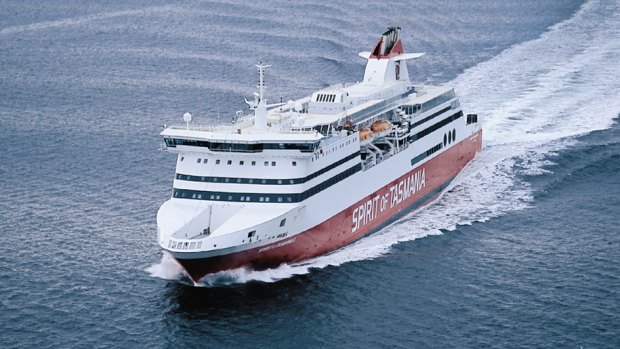
The Spirit of Tasmania.
"Shut ya traps," she barks, then points me in the direction of a coin box in the next room.
The campsite is best described as barren. It's ringed by vans big and small, with a scattering of tents and several backpackers sleeping inside cars.
We find a vacant space to park the van against the fence at the far end. It's not ideal, but at least we can open our side door onto a row of she-oaks and enjoy a modicum of privacy. And it will suffice until the morning, when I've arranged for us to visit the Tasmanian Devil Unzoo in Taranna.
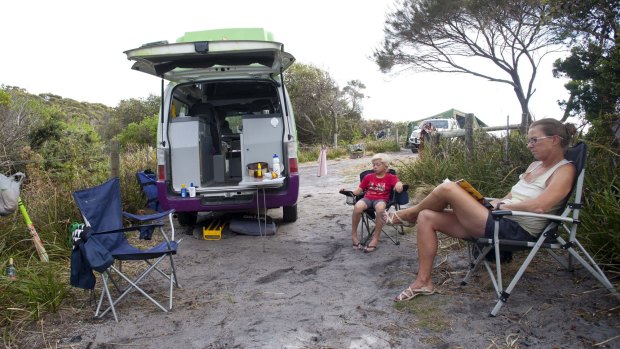
Camping at Cosy Corner.Credit: Mark Daffey
This is what our son Finn has most been looking forward to. He's never seen a Tasmanian devil before and is brimming with questions. How many are there? Do they really only eat meat? Not even broccoli? How come I have to?
The Tasman Peninsula is the last quarantined refuge against Devil Facial Tumour Disease (DFTD). The disease is slowly killing the population of Tasmanian devils. John and Caroline Hamilton's wildlife sanctuary educates visitors about the plight of the devils and monitors wild devils through its daily Devil Tracker Tour.
Finn is fascinated by the barbaric behaviour of two hungry devils tussling for control of a cut of pademelon during feeding time, and the fact that they eat everything that's given to them – fur and bones included. It's a practice he isn't used to adhering to at home.
The next feeding time is more civilised, as well as interactive. Delighted men, women and children of all ages and nationalities enter an enclosure where Foresters kangaroos, Bennett's wallabies, pademelons and Cape Barren geese nibble grain pellets from outstretched hands.
We camp that night at Fortescue Bay, in the Tasman Peninsula National Park. It's every bit as good as the more celebrated Wineglass Bay further north and similar in appearance, with a concave beach bookended by forested headlands that almost touch.
The bay's translucent water wills us into it and the sand is as soft as a pillow. Finn immediately notices that this beach's gradient is purpose-made for games of cricket, unlike the steeply pitched beaches at Binalong Bay. He soon coaxes us into playing.
I wanted to camp at Fortescue Bay so we could hike to Cape Hauy, a seesawing promontory that's famous among rock climbers for a slender sea stack called the Totem Pole. The nine-kilometre return hike from the bay is the final section on the newly opened Three Capes Track, traversing hills that plunge dramatically into the sea far below. Beneath those dolerite walls, tour boats constantly come and go and we watch as a group paddles in kayaks towards the cape.
The scenery is stunning, though our eight-year old couldn't care less. Hiking over endless hills is not his idea of fun and he lets us know it. Michelle suggests we guess how many steps there are to the top of the longest hill climb. It works a treat as we count them out while we walk, swapping after batches of 50. There are also rewards in the form of lollies every 20 minutes.
Dolphins frolic inside Fortescue Bay as we depart for Port Arthur on our penultimate morning. The entrance fees for the retired convict settlement are hefty, though they include a 40-minute introductory walking tour and a 30-minute boat ride around the harbour. The young gent behind the counter also hands over an iPod and headphone set, lanyards for the three of us, playing cards so each of us can identify with a convict of a similar age and sex in the museum, an activities book for Finn, a visitor guide brochure and two lots of receipts. A bag to pile them all into would have been a thoughtful addition.
In no way does the picturesque seaside village before us resemble the one that early 19th-century convicts would remember. Steepled churches rise above rolling hills, where oak trees and picket fences border manicured gardens. There's even a cricket ground.
Though our passes are valid for two days, we don't have that much time. I've arranged to spend our last night at Narawntapu National Park in the far north, close to where we'll be able to reboard the ferry at Devonport. We spend the morning strolling among the convict ruins before following the Heritage Highway north through the interior, passing by and, sometimes through, some of Tasmania's most historic towns. Richmond, Oatlands, Ross and Campbell Town pass by in a blur as we race to reach Narawntapu before dusk.
Celebrity naturalist Harry Butler once described this park as the "Serengeti of Tasmania". It's a name well chosen, for hundreds upon hundreds of Forester kangaroos, pademelons and Bennett's wallabies spread out across an ancient Aboriginal hunting ground. There are common wombats and echidnas, and native hens that are affectionately called "turbo chooks". All that's missing is a purple bear.
Mark Daffey visited Tasmania courtesy of Spirit of Tasmania and JUCY campervans.
TRIP NOTES
MORE INFORMATION
GETTING THERE
Spirit of Tasmania departs nightly from Station Pier in Port Melbourne and from The Esplanade in East Devonport. For most of the summer, as well as during high demand periods, you can also embark on day sails; see spiritoftasmania.com.au.
GETTING AROUND
Tasmania is tailor-made for vehicle touring. The JUCY "Condo" van comfortably fits two adults and a child. It costs $110 a day, plus $30 a day for "stress-free" insurance; see jucy.com.au.
STAYING THERE
National Parks campsites have reasonable fees but there are many free alternatives. Most require campers to be self-sufficient. Drop toilets are often the only facilities provided though some have bathroom facilities, gas barbecues and shelters. Don't count on power for your van though. See parks.tas.gov.au.
Sign up for the Traveller Deals newsletter
Get exclusive travel deals delivered straight to your inbox. Sign up now.